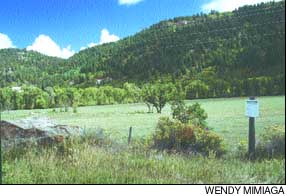|
Sept. 19, 2000 By Jim Mimiaga The Montezuma County Commission late Monday unanimously approved a high-impact permit for a gravel pit that has sparked controversy for weeks.
Four States Aggregate will be allowed to operate a large gravel-mine on the Line Camp property in the Dolores River Valley the commission told a crowd of about 40. However, the board imposed several restrictions designed to mitigate impacts on neighboring residents. Expressing concern about the effects of traffic and noise and about reclamation efforts after the five-year mining operation is complete, the commission handed down the following additional rules that would not be required under the state-permitting process. The county-approved permit with these stipulations will be drawn up this week.
The commissioners said they will push for having CDOT install an acceleration lane for trucks turning south from the pit onto the highway, and emphasized the importance of Four States trying to maintain safe trucking operations. Regarding the devaluation of property rights as a result of the pit, the commissioenrs said that they have found this not to be necessarily true. They cited as an example the Twin Spruce subdivision, also in the Dolores River Valley, near a expired gravel pit and an ongoing housing development and land sales going on near the Sunnyside pit, which is compete but yet to be reclaimed. The commissioners felt that while property values may drop tempoarily during the lifespan of the operating permit, they tend to rebound after mining and reclamation is complete. "Take a look at La Plata County and Dalton Ranch," said Commissioner Kent Lindsay. "That is a high-dollar (housing) development next to a huge gravel-pit operation. I beg to differ with gravel pits reducing property values" in the long run. Four States owner Aryol Brumley promised to mitigate noise as much as possible. He said that actual mining and crusher operations, the most disruptive portion of the mine proposal, will only be going on for two months out of the year, in the late summer and fall. "Actual production is not long-term, 24 hours per day, seven days a week all year," Brumley said. "There will be peak periods but not for months and months at a time." "Our biggest challenge is balancing property rights with property values," Commissioner Gene Story said, adding that "to be a good neighbor, adjustments must be made when an undesirable situation is created." Before the decision was made to approve the permit, public comment at the hearing — which had been continued twice — was again heard, offering a prelude to arguments that will likely be made in court against the gravel pit. Representing Carol Stepe, a vocal opponent of and neigbor to the Line Camp pit, attorney Tim Tuthill spoke on the impacts the operation will have on the quality of life for neigbors, and specifically cited land-use code language supporting the protection of property values and the rural character of the county. "The impact on the adjoining properties will be devastating," Tuthill said, showing a photograph of the mine site as seen from Stepe’s house. "(The land-use code) ensures that development does not cause significant adverse impact on other properties in the area. This will cause a reduction in property values." Tuthill and others called for more appropriate alternatives to the 50-acre Line Camp site on lands also owned by Truelson, who is leasing 19 acres of the Line Camp land to Four States Aggregate. Pete Robinson, who lives next door to the Line Camp, was suspicious of whether mitigation efforts outlined Monday would be enforced adequately. Adminstrator Tom Weaver responded that county gravel pits are constantly getting inspected by state authorities, and that there is not a shortage of state oversight. "There are a lot of signed petitions; the oppostion to this is clear," said Jack Robbins, a Line Camp neighbor. "I believe this will be tied up in courts for a long time." The pit, located 9 miles north of Dolores, will mine high-grade sand and gravel for paving roads and for commercial cement used for foundations and driveways. Over the next five years between 130,000 and 150,000 tons per year of gravel is expected to be taken from the site. The material will not be sold for use by the Montezuma County road department, which operates five gravel pits on a rotating basis in order to maintain the 800 miles of roads here. Rather, Four States Aggregate hopes to provide gravel for the large repaving effort now under way on state-maintained Highway 145, and for the regional construction trade. |
||||
|
Copyright © 2000 the Cortez
Journal. All rights reserved. |
